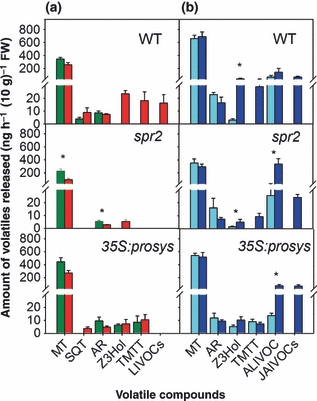Fig. 5.

Leafminer (Liriomyza huidobrensis)- and jasmonic acid (JA)-induced volatile compounds released from three tomato genotypes. The volatile profiles include undamaged ( ) and leafminer-damaged (
) and leafminer-damaged ( ) tomato plants (a), and 0.5% alcohol-treated (
) tomato plants (a), and 0.5% alcohol-treated ( ) and JA-treated (
) and JA-treated ( ) plants (b). MT, monoterpenes (α-pinene, 2-carene, α-phellandrene, limonene, β-phellandrene); SQT, sesquiterpene (β-caryophyllene); AR, aromatic (p-cymene); Z3Hol, (Z)-3-hexenol; TMTT, (3E,7E)-4,8,12-trimethyl-1,3,7,11-tridecatetraene; LIVOCs, other leafminer-induced volatile organic compounds ((Z)-3-hexenyl butyrate, (Z)-3-hexenyl acetate); ALIVOC, alcohol-induced volatile compounds (butanoic acid, ethyl ester); JAIVOCs, other JA-induced volatile compounds ((E)-β-ocimene, (E)-2-hexenal, (Z)-3-hexenyl acetate, propanoic acid, ethyl ester). Compound lists of tomato genotypes and treatments are presented in the Supporting Information (Tables S2, S3); comparisons among genotypes or between treatments are presented in Table S4. Bars indicate means ± SEM; *, P <0.05. In (a) there were five replications per genotype per treatments (N=5). In (b) there were four replications per genotype per treatments (N=4).
) plants (b). MT, monoterpenes (α-pinene, 2-carene, α-phellandrene, limonene, β-phellandrene); SQT, sesquiterpene (β-caryophyllene); AR, aromatic (p-cymene); Z3Hol, (Z)-3-hexenol; TMTT, (3E,7E)-4,8,12-trimethyl-1,3,7,11-tridecatetraene; LIVOCs, other leafminer-induced volatile organic compounds ((Z)-3-hexenyl butyrate, (Z)-3-hexenyl acetate); ALIVOC, alcohol-induced volatile compounds (butanoic acid, ethyl ester); JAIVOCs, other JA-induced volatile compounds ((E)-β-ocimene, (E)-2-hexenal, (Z)-3-hexenyl acetate, propanoic acid, ethyl ester). Compound lists of tomato genotypes and treatments are presented in the Supporting Information (Tables S2, S3); comparisons among genotypes or between treatments are presented in Table S4. Bars indicate means ± SEM; *, P <0.05. In (a) there were five replications per genotype per treatments (N=5). In (b) there were four replications per genotype per treatments (N=4).
